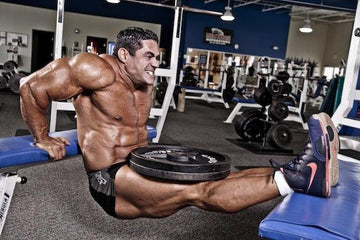

The Complete Woman's Guide to Six Pack Abs
Table of Contents
Most women think that to get a slim and sexy stomach, they need to increase the number of sit-ups they do every day. Sit-ups by themselves will work the muscles of the stomach, but they don’t burn that many calories and, therefore, will not burn that much body fat. It’s best to include other forms of exercise and a calorie controlled diet to achieve excellent results. This may surprise many women, but sit-ups are not a good abdominal exercise for core strength.
Research conducted at the Human Performance Laboratory at Montclair State University reported that the traditional sit-up may be a poor choice for core strength training due to its focus on hip flexion. Researchers examined differences in abdominal and hip flexor muscle activation and trunk and hip kinematics between the traditional US Army sit-up and a modified sit-up focusing on trunk flexion.
Traditional Sit-UP
Modified-Sit-UP
Eighteen trained males performed 30 seconds of repetitions of each sit-up style while muscle activation of the rectus abdominis, external oblique, and rectus femoris was recorded using electromyography (EMG). At the end of the study, the researchers found that the maximum EMG of the rectus femoris and external oblique, and mean muscle activation of the rectus femoris were greater during the traditional sit-up. This means that the traditional sit up you see many women doing are not effectively exercising your abdominals. In contrast, the modified sit-up activated the rectus abdominis and external oblique greater than the traditional sit-up. In short, the traditional sit places greater emphasis on hips during this sit-up style, which may result in lumbar hyperextension and a higher chance of injury. The greater abdominal activation of the rectus abdominis and external oblique activity and peak trunk flexion during the modified sit-up suggests a greater emphasis on trunk flexion during this exercise, which may decrease the lumbar spine load. Therefore, the modified sit-up may be a better exercise selection to train the abdominal muscles.
Spot Reduction Does Not Work
For example, to show how spot reduction is just a myth, check out the study below: The purpose of this study was to investigate the effect of abdominal exercises on abdominal fat. Twenty-four healthy, sedentary participants (14 men and ten women), between 18 and 40 years, were randomly assigned to 1 of the following two groups: control group or abdominal exercise group. Anthropometrics, body composition, and abdominal muscular endurance were tested before and after training. The abdominal exercise group performed seven abdominal exercises, for two sets of 10 repetitions, on five days a week for six weeks. The control group received no intervention, and all participants maintained an isocaloric diet throughout the study.
At the end of the study, there was no significant effect of abdominal exercises on body weight, body fat percentage, android fat percentage, android fat, abdominal circumference, abdominal skinfold and suprailiac skinfold measurements.
The abdominal exercise group performed a significantly greater amount of curl-up repetitions compared to the control group on the post-test. Six weeks of abdominal exercise training alone was not sufficient to reduce abdominal subcutaneous fat and other measures of body composition. Nevertheless, abdominal exercise training significantly improved muscular endurance to a greater extent than the control group.
After 12 weeks, both groups had the same weight decrease, abdominal subcutaneous fat, waist circumference, hip circumference, body mass index, body fat percentage, and skin fold thickness.
When you take in more calories than your body burns, you store the extra calories as fat. More than half of the fat in your body is stored underneath your skin and over your muscles. Your stomach will look better when your belly muscles are strong, but sit-ups or crunches will not remove extra fat from your stomach. The only way to lose fat from a specific part of your body is to lose weight overall.
Choose High-Intensity Exercise Over Low Intensity for Fat Loss
To control abdominal fat, you need to participate in regular high-intensity exercise (HIIT), according to the experts. Previous studies have demonstrated significant reductions in visceral fat and subcutaneous fat as a result of high-intensity exercise training. Endless hours in the gym aren’t needed either. A HIIT training involves a mix of speed and power in intervals lasting from 30 seconds to several minutes, followed by rest periods lasting for about one to five minutes. So you might try sprinting as fast as possible for 30 seconds followed by walking for five minutes, then sprinting again, four to five times a session.
For example, one study demonstrated an exercise training-induced reduction in visceral fat, abdominal subcutaneous fat, and total abdominal fat. What that means is there was a relationship between the exercise intensity and the amount of fat lost in the study. In fact, according to new research, a short few minutes a few times a week of high-intensity interval training, or HIIT, should be enough to help you burn off that last belly fat bit. As reported in the Journal of Obesity, HIIT is more effective than traditional aerobic exercise for belly fat reduction. According to the researchers, the reasons may have to do with increased fat metabolism during and after exercise, a better balance of blood sugar, better sensitizing the body’s insulin response and even decreased appetite post-exercise.
Here are two studies to consider that show the positive impact of exercise intensity on weight loss:
Researchers took 27 middle-aged obese women with metabolic syndrome and subjected them to one of three exercise programs.
- Group 1 was the no-exercise control group;
- Group 2 was a low intensity (aerobic) exercise group;
- Group 3 was the high intensity (HIIT) exercise group
Groups 2 & 3 performed five workouts per week @ 400 calories per workout.
After 16 weeks, the HIIT group had significantly reduced total abdominal fat, abdominal subcutaneous fat, and most importantly abdominal visceral fat. Sadly, Groups 1 & 2 saw no significant changes in fat loss.
In study #2, researchers took 45 average women and subjected them to a 15 week HIIT exercise program.
As in the first study, the women were divided into three groups.
- Group 1 was the no-exercise control group;
- Group 2 was the low intensity (aerobic) exercise group;
- Group 3 was the high intensity (HIIT) exercise group
After 15 weeks, both exercise groups demonstrated a significant improvement in cardiovascular fitness. However, only the HIIT group had a significant reduction in:
- total body mass (TBM),
- fat mass (FM),
- trunk fat
- and fasting plasma insulin levels
High-Intensity Training (HIIT or HIRT) is more effective than cardio training for burning off belly fat. If you want to get rid of Belly Fat, You Need to Perform High-Intensity Exercise
High-Intensity Exercise Burns Belly Fat
If you’re at the gym and able to talk to your friend while walking on the treadmill, you may not be exercising hard enough. A recent study may have put the nail in the coffin for steady state exercise cardio. To examine the influence of moderate-intensity (50% of VO2peak) exercise training versus high-intensity (75% of VO2peak) exercise training on regional fat distribution, researchers randomized 18 overweight women to high-intensity, moderate-intensity, or a control group (CON). Subjects enrolled in high-intensity or moderate-intensity completed a 12-week exercise training protocol designed to expend 1000 kcal/week. Body composition testing was completed before and following the exercise training.
At the end of the study, VO2peak improved in high-intensity and moderate-intensity whereas there was no change in VO2peak in control. No significant change in body weight, BMI, and % fat occurred in moderate-intensity, high-intensity, or control.
Although there was a significant reduction in visceral fat with high-intensity (−39 cm2), there was no change in the moderate-intensity or control groups. Also, there was a significant increase in thigh muscle attenuation in the high-intensity group. There were no changes in thigh muscle attenuation in the moderate-intensity and control groups.
In summary, direct comparison of exercise intensity without weight loss promotes the efficacy of high-intensity in the reduction in visceral fat. Researchers suspect that the reason high-intensity exercise burns belly fat better is that the body produces more hormones like adrenalin at a higher intensity, and the body more easily lays claim to its fat reserves. A second factor may be the EPOC, the higher level of energy burning experienced after a training session. The more intensive the training, the more intense the EPOC.
How to Burn More Calories after Exercise
After you stop exercising, the body needs time to restore the substrates lost during exercise back to normal, and this requires energy. Originally suggested by physiology researcher, Archibald Hill in 1922, “oxygen debt,” (re-named EPOC) requires that the body continues to burn burning calories at an increased rate following exercise.
This excess oxygen is what we refer to as EPOC or Excess Post-Exercise Oxygen Consumption. Excess post-exercise oxygen consumption is a measurably increased rate of oxygen intake following strenuous activity intended to replenish what the body burned during exercise. The body needs extra oxygen to replenish fuel stores, repair tissues, and increase anabolism. EPOC is accompanied by an elevated consumption of fuel. In response to exercise, fat stores are broken down and released into the blood stream.
This good news for the dieter trying to lose weight as it means your metabolism is still running higher than it was before exercise. Its known as the “afterburn” effect, its much like touching your engine after its been running, it’s still hot. This amount of excess oxygen is used by the body to help it recover after a bout of strenuous physical activity. Two things affect EPOC: The duration and intensity of the exercise performed determines how long this recovery period will last.
Light to moderate activity causes a very mild stimulus to the body and thus requires a short and typically unnoticeable recovery period. On the other hand, high-intensity exercise can result in recovery periods that can last hours. It’s very straightforward. By incorporating some high-intensity workouts in your weekly routine, you will not only burn more calories during the workout, but you will burn additional calories during the recovery period.
How to Burn the Most Calories During Your Workout.
At the end of the study, the combined magnitude of the EPOC from the two intermittent bouts was significantly greater than that of the continuous cycling and running.
Its been well established that intense resistance exercise burns more calories than a bout of endurance exercise. Researchers at Oregon Health Sciences University investigated the difference in EPOC between aerobic cycling, circuit resistance training, and heavy resistance training and reported that heavy resistance training yielded the most significant EPOC results. A similar study took place at Colorado State University. The research team compared a strength-training workout with a 60-minute aerobic session. Lead author CA Gillette reported that resistance training elicited a significantly greater EPOC response than the cardio workout.
To get the most significant benefits from EPOC, your exercise intensity must be high. A study performed at the Virginia Commonwealth University, whose results indicate that a workout performed for two sets of eight repetitions at a heavier weight yields greater EPOC benefits than the same exercises performed for 15 repetitions at a lighter weight. A new study was released this week which suggests that EPOC can be elevated by splitting your workout into two parts for greater benefits. Researchers had ten healthy men, aged 23-34yr, performed four bouts of exercise after measuring maximal oxygen consumption after a running and cycling test. The workout groups were:
– Running one session to burn 400 calories
-Cycling 1 session to burn 400 calories
-Running two sessions per day (i.e. 200 calories each session) to burn 400 calories
-Cycling 2 sessions per day (i.e. 200 calories each session) to burn 400 calories.
All sessions were performed at 75% of the running and cycling oxygen uptake reserve. Exercise bouts were separated by 72h and performed in a randomized, counter-balanced order. The VO2 was monitored for 60-min postexercise and 60-min during a control non-exercise day.
At the end of the study, the combined magnitude of the EPOC from the two intermittent bouts was significantly greater than that of the continuous cycling and running.
The exercise modality had a significant effect on net EPOC, where running elicited a higher net EPOC than cycling. Intermittent exercise increased the EPOC compared to a continuous exercise bout of equivalent energy expenditure. Furthermore, the magnitude of EPOC was influenced by exercise modality, with the greatest EPOC occurring with isocaloric exercise involving larger muscle mass (i.e., treadmill running vs. cycling). So in sum, if you want maximal fat burning after exercise, try breaking up your workout into two sessions instead of 1 longer session and use exercises such as running which require more muscle activated during exercise.


















